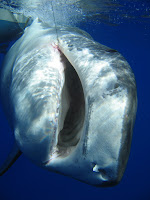 Every Saturday in January, the National Geographic Channel is airing a new episode of Dangerous Encounters with Brady Barr. You may remember Barr from two years ago when he was famously bitten by a twelve foot long python. Well Barr has had time to recover an in the last episode in the series on January 24, he returns to that same cave again looking for rumored fifty foot pythons.
Every Saturday in January, the National Geographic Channel is airing a new episode of Dangerous Encounters with Brady Barr. You may remember Barr from two years ago when he was famously bitten by a twelve foot long python. Well Barr has had time to recover an in the last episode in the series on January 24, he returns to that same cave again looking for rumored fifty foot pythons.But before then, tonight Barr is on a journey to find the elusive Sixgill Shark (seen at right, so Spoiler Alert!: he finds them) which scientists have very little knowledge of the Jurassic sharks. Barr sets out to change that traveling to Central America, Puget Sound, Hawaii and 1,700 feet below the surface of the ocean (in the submarine seen at left). To put that in perspective, more people have seen the summit of Mt. Everest that been that far under the ocean.
 Then next Saturday, Barr travels to South Africa to put satellite transmitters on crocodiles to see how they migrate after a dam threatens their current habitat and January will be on the hunt for the world’s largest salamanders which can grow up to five feet and eighty pound. I may go into further details about future shows later but until then, head over to the Dangerous Encounters website for these goodies:
Then next Saturday, Barr travels to South Africa to put satellite transmitters on crocodiles to see how they migrate after a dam threatens their current habitat and January will be on the hunt for the world’s largest salamanders which can grow up to five feet and eighty pound. I may go into further details about future shows later but until then, head over to the Dangerous Encounters website for these goodies:"How to be like a gecko" Game: Take the Dangerous Encounters challenge and prove your gecko skills such as eye licking and wall climbing. How gecko are you?
Dangerous Encounters mobile trivia: Get your danger fix with weekly mobile trivia nd learn surprising facts about some of the world's most most menacing – and even some of the world's oddest – creatures!
Dangerous Encounters podcasts: Watch previews of Dangerous Encounters as Dr. Brady Barr travels around the globe on a series of death-defying, hair-raising expeditions to study reptiles and other creatures in their native habitats.
No comments:
Post a Comment